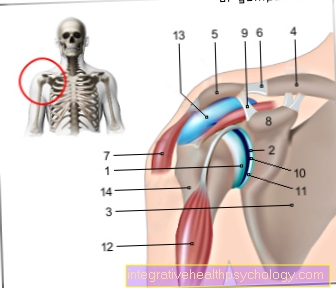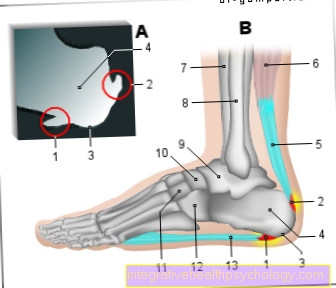Abdominal crunch
introduction
The "Abdominal Crunch" is the most common form of exercise to train the straight abdominal muscles.
As an opponent (antagonist) of the back muscles, training this muscle is particularly important not only for aesthetic reasons. The straight abdominal muscles enable people to keep the upper body upright and are used in health sports, bodybuilding, fitness sports and games. Many sports and athletic disciplines benefit from well-trained abdominal muscles.
Which muscle is exercised in abdominal crunch?
The straight abdominal muscle is trained (Rectus abdominis muscle).
Illustration of the trained muscles


The purpose of the abdominal crunch
The goal that one pursues by regularly performing the Abdominal Crunch is to strengthen and stabilize the straight abdominal muscles.
While the growth of the straight abdominal muscle is sought for aesthetic reasons in many men in order to develop the so-called "six pack" or "washboard abs", the muscles are also of functional importance for everyone: A healthy, well-developed abdominal muscles offer an antagonistic function to the back muscles and thus enables a healthy, upright stand, as well as the lifting of heavy loads, such as water boxes.
The back muscles are naturally stronger, and if the abdominal muscles do not counteract this, a hollow back can develop.
Thus, the abdominal and back muscles are involved in stabilizing the healthy shape of the spine and can prevent back pain and even herniated discs for years.
Exercise description of the Abdominal Crunch
In order to perform the abdominal crunch correctly, the athlete positions a towel on the floor and lies lengthwise on it, head in the middle, so that the towel protrudes 5-10 cm above the head. The legs are bent and the heels are on the floor with the toes pointing upwards.
Now you take the ends of the towel in your hand to the left and right of the head so that the towel forms a support or a kind of "hammock" for the head. This relieves the neck muscles and prevents tension in the neck area.
Now the head and the upper body are detached from the floor by means of a rolling movement, as the abdominal muscles contract. A flat hand's breadth should fit under the lumbar region, then relax the muscles again and let the upper body sink again until it is just above the floor - that is, the muscles are never completely relaxed until the end of the set.
The abdominal muscles belong to the so-called postural muscles, which means that they are designed for slow, static movements. This is exactly how the exercise should be done - slowly and without hasty movements.
Note: No device is required for optimal training of the abdominal muscles. However, this only applies to abdominal muscle training and not to other muscle groups for which training without equipment can be used as a supplement.
Variants of the classic abdominal crunch

The crunches can be modified in many different ways. In addition to training the lower straight abdominal muscles using reverse crunch, the legs can be lifted off the floor if you have back pain. The lower legs form a right angle with the thighs and the thighs with the upper body. You can feel that the lower part of the back is in firm contact with the floor.
Athletes who want to increase the training stimulus can stretch their arms behind their heads. In contrast, the stress can be reduced by keeping the arms straight next to the upper body. The hands are at the level of the thighs.
An expander can also be used to increase the training stimulus. However, this is only recommended for trained athletes.
The Abdominal Crunch exercise is also suitable for statically training the straight abdominal muscles, which means holding the tension for a few seconds. However, this form of contraction is rather strenuous.
Typical errors in execution
It is important to avoid the following typical errors:
- The feet must not be immobilized, even if most fitness equipment allows it and many fitness trainers instruct it. Through this fixation of the legs, the straight abdominal muscles no longer work, but the hip muscles (M. illiopsoas). In general, fitness equipment is better not to be used for this exercise, as it always trains other muscle groups.
- If this exercise is too strenuous for you, the entire upper body should not be lifted, it is sufficient to first lift the upper body only slightly and gradually increase - you should not overdo yourself at the beginning.
- Particular caution applies to lordosis pillows. These pillows are tailored to an ideal back shape. However, if the spine is misaligned, it does not support the back, but damage the back. You can replace the lordosis pillow with a rolled up towel.
- Many athletes pull their head back when performing the movement, that is, they hyperextend the neck backwards. However, this very often leads to tension in the neck muscle area.
Training planning: You should do this many sets
According to the most common training method, classic sets of 3x15 crunches are performed - i.e. three rounds of 15 crunches.
But since you train with your own body weight and want to strain the muscles to a certain extent, you can confidently continue the exercise until you are exhausted, i.e. until you can no longer.
Health assessment of exercise
The abdominal crunch is an exercise that is risk-free in healthy people and can therefore be carried out with confidence, even if the athlete has back pain or sore muscles.
As already mentioned, the Abdominal Crunch strengthens the abdominal muscles and thus contributes significantly to an upright, healthy posture of the spine. So it is definitely beneficial to exercise this muscle group regularly.
However, there are some physical and health conditions in which the exercise should not be performed. These include:
- Pregnancy from the 3rd trimester (7th month),
- Disc prolapse,
- Inguinal hernia and
- if it is expressly forbidden by the doctor.





























